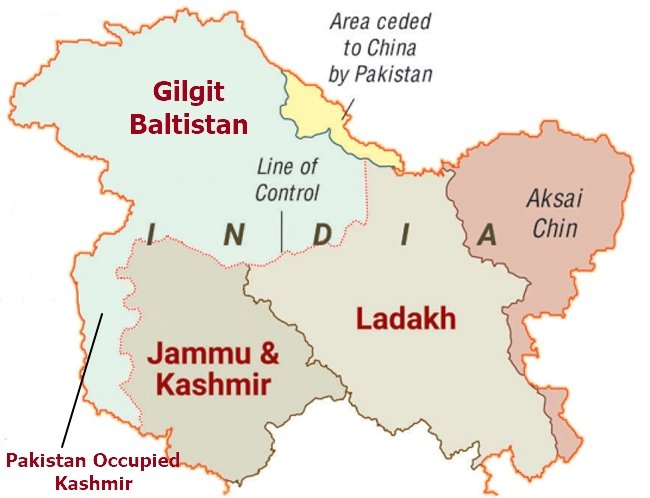- Home
- Prelims
- Mains
- Current Affairs
- Study Materials
- Test Series
What is Ladakh's demand on Gilgit-Baltistan?
- Ladakh’s two key sociopolitical conglomerates, the Leh Apex Body (LAB), representing several Buddhist religious and political parties, and Kargil Democratic Alliance (KDA), representing Muslim religious groups and local parties, submitted a memorandum to the Ministry of Home Affairs, demands include extending the territorial control of Ladakh up to Gilgit Baltistan in Pakistan Occupied Kashmir.
Concerns in Leh and Kargil
- Kargil – Of Ladakh’s two districts, the August 2019 changes were immediately opposed by the people of Kargil.
- The people of Kargil see themselves as a minority in Buddhist majority Ladakh.
- So, the leaders of the majority Shia population in Kargil demanded that the district should remain part of J&K.
- They also demanded that special status be restored.
- This was to safeguard the rights of Kargil people over their land and employment opportunities.
Leh – Opposition from Leh came later
- Leh believed that it was being marginalised in the larger state of J&K.
- So, a UT for Ladakh had been a long-standing demand in Buddhist majority Leh.
- But what Leh leaders did not bargain for was the complete loss of legislative powers.
- Earlier, Leh and Kargil each sent four representatives to the J&K legislature.
- After the changes, they were down to one legislator – their sole MP, and with all powers vested in the UT bureaucracy.
- Unlike the UT of J&K, Ladakh was a UT without an assembly.
- So, the Ladakh districts fear that alienation of land, loss of identity, culture, language, and change in demography would follow their political disempowerment.

|
Gilgit-Baltistan
|
History of the region
- Gilgit was part of the princely state of Jammu & Kashmir, but was ruled directly by the British, who had taken it on lease from Hari Singh, the Hindu ruler of the Muslim-majority state. When Hari Singh acceded to India on October 26, 1947, the Gilgit Scouts rose in rebellion, led by their British commander Major William Alexander Brown.
- In November 1, 1947, a political outfit called the Revolutionary Council of Gilgit-Baltistan had proclaimed the independent state of Gilgit-Baltistan., it declared it was acceding to Pakistan, which accepted the accession only to the extent of full administrative control, choosing to govern it directly under the Frontier Crimes Regulation, a law devised by the British to keep control of the restive tribal areas of the northwest.
- The Gilgit Scouts also moved to take over Baltistan, which was then part of Ladakh, and captured Skardu, Kargil and Dras. In battles thereafter, Indian forces retook Kargil and Dras in August 1948
- Following the India-Pakistan ceasefire of January 1, 1949, Pakistan in April that year entered into an agreement with the “provisional government” of “Azad Jammu & Kashmir” parts that had been occupied by Pakistani troops and irregulars to take over its defence and foreign affairs. Under this agreement, the “Azad Jammu & Kashmir” government also ceded administration of Gilgit-Baltistan to Pakistan.
- In 1974, Pakistan adopted its first full-fledged civilian Constitution, which lists four provinces —Punjab, Sindh, Balochistan and Khyber Pakthunkhwa. Pakistan-Occupied Kashmir (PoK) and Gilgit-Baltistan were not incorporated as provinces.
- In 1975, PoK got its own Constitution, making it an ostensibly self-governed autonomous territory.
- PoK too remained under the control of Pakistani federal administration and the security establishment, through the Kashmir Council.
- Provincial status, on November 1, 2020, observed in Gilgit-Baltistan as “Independence Day”, Imran Khan announced that his government would give the region “provisional provincial status”.
Centre’s stand
- In the wake of street protests held by people in Ladakh, the Centre in 2022 formed a committee under Minister of State G. Kishan Reddy to engage with the members of the LAB and KDA.
- The Centre had assured the people it would find “an appropriate solution to the issues related to language, culture and conservation of land in Ladakh.” However, it has failed to arrive at a solution.
- After a fresh bout protests in 2023, another high powered committee, with Minister of State Nityanand Rai at its head, was empowered to engage with the stakeholders of Ladakh.
- In 2024, these bodies submitted a written memorandum to pave the way for more structured talks between New Delhi and Ladakh over the list of demands.









 Latest News
Latest News
 General Studies
General Studies